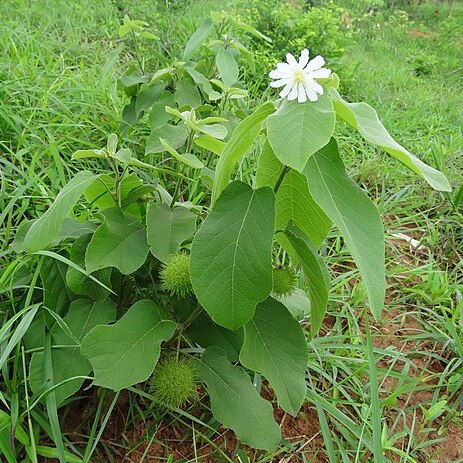Leaf-lamina 5–17 x 3.5–10 cm., ovate-oblong, broadly ovate or obovate, apex acute or obtuse, base cordate, margins serrate, pilose above and tomentose below, at least when young; lateral nerves in 6–9 pairs with 5–7 basal nerves, slightly prominent above, very prominent below, venation reticulate and prominent below; petioles up to 7 cm. long, golden-tomentose; stipules c. 1 cm. long, lanceolate to linear-lanceolate, acuminate at the apex, yellowish-tomentose.
Flowers bisexual, white, in 3–8-flowered, axillary cymose panicles; peduncle 1–3 cm. long, golden-tomentose; pedicels similar, c. 1 cm. long; bracts at the base of the pedicels c. 7 mm. long, narrowly elliptic, cucullate, apex acuminate, the margins serrate, tomentellous.
Ovary ellipsoid to globose, covered with soft, puberulous, setose processes; style slender, c. 5 mm. long, puberulous except near the tip; stigmatic apex not wider than the style.
Fruit a globose capsule, echinate with many puberulous, branching bristles or spines, up to 4.5 cm. in diam. with the bristles, dehiscing into 3 valves, bristles 1.5–2 cm. long.
Petals 8–12, c. 2 x 0.7 cm., obovate-oblong, blunt at the apex, narrowed at the base, margin somewhat undulate, tomentose on the back.
Small bush usually from 0.3–1 m. tall; branches stiffly erect, golden-tomentose at first, later glabrescent and brownish-purple.
Stamens very numerous; filaments 3–5 mm. long, slender, puberulous; anthers c. 5 mm. long, linear, puberulous.
Sepals 1–1.5 x 0.5–0.7 cm., elliptic, blunt at the apex, with many puberulous, setose processes at the back.
Seeds several, c. 4 x 4 mm., compressed; testa pubescent; aril dark brown when dry.


